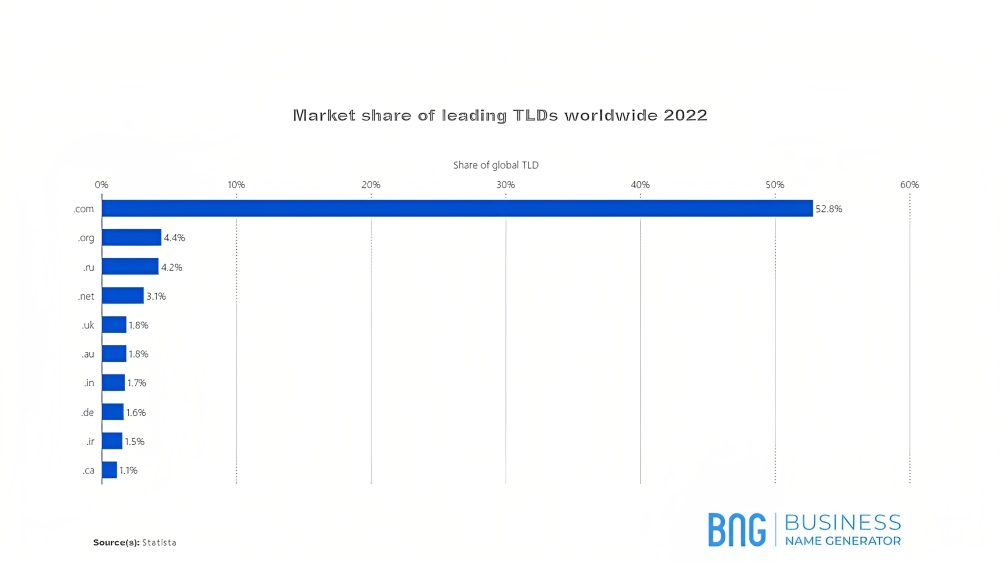What Is a TLD?
A top-level domain (TLD) represents the final segment of a domain name and is the last part that comes after the dot.. For example, in businessnamegenerator.com, the top-level domain is .com. TLDs are top-level as they are at the highest hierarchical level in the domain name system (DNS) right after the root domain.
Top-level domains are essential for how the domain name system (DNS) servers communicate during the lookup process. They are also important for classifying domain names and letting users understand the website’s purpose.
This article will review different types of top-level domains and why your business needs to pick a suitable TLD.
| Key Points |
|---|
| A top-level domain comes after the last dot in the domain name. |
| A TLD shows the purpose of a website. |
| While it doesn’t directly affect SEO, it affects users’ perceptions of your business. |
Types of Top-Level Domains
A fully-qualified domain name consists of three domain name levels:
- Top-level domain: This is also known as an extension.
- Second-level domain: The unique part of the domain name that you need to choose. You can use your business’s name or a keyword that will help you direct traffic to your website.
- Third-level domain: Comes before the first dot in the name. They either refer to subdomains or the website host (usually www).
When we talk about domain types, we refer to top-level domains as they show the purpose of a website in advance. Nowadays, these purposes are not as defined as they were early on. For example, the .hr extension communicates to DNS servers that the website is from Croatia, but many staffing agencies and HR companies use it as a branding tool.
When it comes to TLD classifications, you’ll find different types of top-level domains, depending on the source you’re using. For instance, Cloudflare isolates .arpa as a standalone infrastructural TLD.
MORE: What is a domain name system (DNS)?
Popular TLD Classifications
We’ll stick with the most popular classification, which is as follows:
- Generic top-level domains (gTLDs): They are the most recognizable and widely used. gTLDs can represent a specific industry or notation. For example, .net is short for network, .com for commercial, and .org for organization.
- Country code top-level domains (ccTLDs): Usually containing only two letters, these domains represent countries. It’s not uncommon today for companies to use ccTLDs from remote places as a branding option (e.g., Anguilla’s ccTLD is .ai).
- Internationalized country code top-level domains (IDN ccTLDs): Domains dedicated to websites that use a non-Latin script, such as Chinese, Japanese, and Arabic.
- Test top-level domains (tTLDs): These are used to test website updates and build documentation. You can’t use a tTLD to create a public website.
Market Share of Top-Level Domains With Examples
By far, the most popular domain is .com. In fact, there are no available dot-com domain names that contain only three or four letters. While .com stands for company, non-business entities also use the extension as their preferred one. According to Statista, over 50% of all websites use .com.
The longer you wait to register a domain name, the more difficult it will be to find one that’s both available and has a popular TLD, such as .com, .net, .us, and .co. In that case, you need to opt for a less popular TLD or buy the domain name from its current owner.
Top-Level Domain Examples
As of May 2023, there were 1,479 top-level domains available on the internet. As a business owner, you can’t choose all of them as some have limited uses, such as .mil used only for domain names owned by the U.S. military. Out of the 1,479 top-level domains, 247 are ccTLDs.
Check out the table below to learn what the most popular TLDs are from each type:
| Type of Top-Level Domain | Examples |
|---|---|
| gTLD | – .com – .net – .org – .gov – .biz |
| ccTLD | – .us – .de – .it – .fr – .es – .ca |
| IDN ccTLD | – .укр – .ελ – .中国 – .გე |
| tTLD | – .example – .localhost – .test |
New Top-Level Domains
The Internet Corporation for Assigned Names and Numbers (ICANN) maintains the domain name system and manages the database with domain names. In 2013, ICANN introduced new TLDs that allow businesses (and individuals) to use a creative TLD that specifies what they’re all about.
According to John Mueller, Google’s search advocate, websites with an nTLD doesn’t have any penalty or preference when it comes to SEO.
“The newer top-level domains are equivalent to other generic top-level domains like .com when it comes to SEO. Pick something you like, there are lots of options out there now.”
While most users trust well-established TLDs more, you can use a new TLD for branding purposes. Some examples of new top-level domains include:
- .coffee
- .restaurant
- .tech
- .design
- .pizza
- .shop
- .art
MORE: Domain name trends
Leading Top-Level Domain Statistics
According to nTLDStats from Statista, the .xyz domain is the most popular among the new ones, followed by .online and .top.
Why Are TLDs Important?
As a business owner wanting to establish an online presence, TLDs are essential to your domain name. Unfortunately, choosing an unknown TLD (or one associated with spamming) can make users think of you as untrustworthy and discourage them from visiting your website.
Research from Growth Badger shows that .com domains are more memorable and trusted. For example, let’s say your business name is StarHive. Users who want to visit your website but don’t know your domain name will likely assume it’s starhive.com. It would be bad for your business if the website using that name existed but belonged to another company.
Least Trustworthy TLDs
Additionally, make sure you avoid TLDs that are associated with spamming and phishing scams. Your website might be perfectly fine, but 2020 research from SEMrush, found the below sites are most commonly associated with scams:
- .zip
- .review
- .country
- .kim
- .cricket
How TLDs Affect SEO
Technically speaking, TLDs don’t affect SEO, with Google and other search engines trying to recommend top-quality content regardless of the domain name it comes with.
Still, they indirectly affect your SEO ranking through people’s perception and likeliness to visit a website. With .com being the most trustworthy, yourBusiness.com will likely get more clicks than yourBusiness.xyz.
Using a ccTLD can help you with geo-targeting and improve buyer confidence if you want to sell your product or service in a specific location. For example, if you want to sell shoes in Mongolia, you’ll be more successful with shoes.mn instead of shoes.ca.
How to Choose the Best Top-Level Domain
While you can always transfer your website to another domain name, you’ll lose customers’ familiarity and your SEO ranking when doing so. That’s why it’s important to choose the best name right in the beginning and stick with it as long as possible.
When picking a domain name, you should take the following steps:
- Dot-com domains reign supreme and should be your go-to choice,
- If they’re unavailable, opt for a TLD that represents your website and business,
- Think of what your website will be about,
- Use ccTLDs as keywords for a specific industry or type of content.
ccTLD Industry Examples
We’ve summarized below what the best ccTLD might look like in your chosen industry.
| ccTLD | Original Country | New Purpose |
|---|---|---|
| .it | Italy | IT companies |
| .fm | Federated States of Micronesia | Radio stations |
| .tv | Tuvalu | Television and streaming services |
| .me | Montenegro | Personal blogs and brands |
| .ai | Anguilla | Companies working with artificial intelligence |
| .hr | Croatia | HR companies and staffing agencies |
| .io | British Indian Ocean Territory | Technology and SaaS companies |
Consider Buying Many TLDs
There are multiple reasons why you should get more than one domain name, i.e., multiple domain types with the same name (e.g., yourBusiness.com, yourBusiness.net, and yourBusiness.co). This allows you to determine which one works best and attracts the most users.
Additionally, it protects you from competitors that might try to cybersquat, i.e., use a similar domain name to trick your customers into buying their products.
Takeaway Points
Aside from the technical intricacies, top-level domains have an important purpose in your online branding. Depending on which TLD you use, drive traffic to your website, or people may avoid clicking on your links regardless of what you offer.
The .com extension is by far the most popular one, but you don’t have to go with it, and a different TLD might be a better choice for your business. If you need help choosing a domain name (with its extension), use our AI-powered domain name generator. It will create 1,000s of name ideas and automatically check domain name availability for various extensions.
Frequently Asked Questions (FAQ)
- .com: commercial businesses
- .net: network
- .org: organizations (usually nonprofit)
- .gov: government agencies
- .edu: educational institutions


